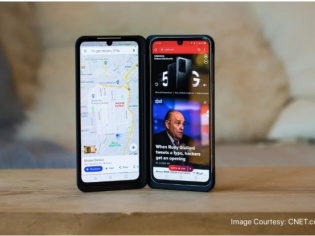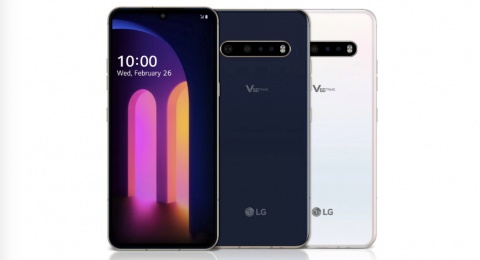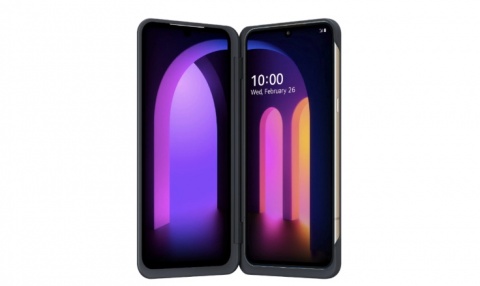-
Team TechTree
09:01 28th Feb, 2020
Will LG V60 ThinQ Stand Up to Foldable Phones? | TechTree.com
Will LG V60 ThinQ Stand Up to Foldable Phones?
This is the third dual-screen phone from the Korean giant which hasn’t yet set the smartphone market alight

The growth story of LG has been a legendary one. The company, which came to fore as a consumer electronics brand worth reckoning only in this millennium (in spite of having been around for close six decades), is today the name to beat in several segments such as television, washing machines and kitchen appliances.
However, the one division within LG that has struggled to keep pace with the world has been the one related to smartphones. Though their phones have been available for several years, none of the devices emerged as a marquee model. As a result, most of their phones arrive and silently pass into history, without as much as a rumble.

And nothing has changed for their latest launch, the LG V60 ThinQ (pronounced thin-queue), the company’s third dual screen offering after the lukewarm response to the LG V50 ThinQ and the G8X ThinQ. And, if you thought the name itself is a dampener, well, join the club as why would anyone want to buy a device named after its size? Or is it the IQ?
Even if we were to pass the bad pun, why does LG think that a dual-screen offering would work in an era where the foldables are making a return? Just in case, you aren’t aware of LG’s approach to screen dynamics, the ThinQ has a second display that fits into a case and can be separated from the main phone.
Writing on TheVerge.com, Chris Welch says the phone at best feels “iterative, especially in the design department.” Which is true, as besides the 5G compatibility via the latest Qualcomm processor and some tweaks to the camera and the continuance of the headphone jack, the new model feels just like its predecessors.
Let’s take a quick look at what’s on offer with the new model. Compared to the V50 from last year, the V60 has a larger 6.8-inch OLED display that offers rich and vibrant colors with 2460 x 1080 pixels. The pixel density of 395 ppi is way below that of the latest Galaxy S20 (563) or even the Pixel 4 XL (537 ppi).
Running on the latest Qualcomm Snapdragon 865, the device offers 128 GB of storage and 8GB of RAM though there is an expandable storage of 2TB available on the side. This 5G-enabled phone also comes with wireless charging and fast charging 4.0. On the camera front, the phone offers two rear cameras where others are offering four or even more.

However, the 13-MP wide angle lens and the 64-MP standard cameras provide enough shooting power for most users as it delivers full resolution or around 16-MP that provides some decent close-ups that telephoto lens provides. LG is using a technique called “pixel binning” which combines the sensor pixels to enhance resolution by a factor of four.
So, what’s the brouhaha about the two screens? Like in the past, the second screen fits the primary one perfectly with the same size and resolution. Earlier, it could only render LG’s native apps across the two screens simultaneously but in the latest device it renders Google Apps such as Photos, Maps, YouTube etc. that work in the wide view mode.
Of course, when one holds the display vertically, the apps stretch across the two displays with a divide in the middle. Not the best user experience that one can get. However, it is in landscape mode that the display performs at its best with one of them doubling up as a full screen keyboard that allows more complicated tasks to be rendered easily.
On the audio front, the device offers 32-bit hi-fi DAC with balanced stereo speakers plus the headphone jack that is now slowly disappearing from more and more devices. The fingerprint sensor and the quick charge are features that add to LG’s must-haves without really increasing the fashion quotient in anyway.
And how much would the V60 ThinQ cost? The company hasn’t revealed the price point though they do claim that it would be lower than the Galaxy S20, which starts at just short of $1000 in the United States. The LG V50 ThinQ cost around $1152 when it launched while the G8X ThinQ dropped prices to $780 and both were 5G enabled.
Does this mean LG could just be creating a price threshold for 5G-enabled phones that other manufacturers would be forced to follow?
TAGS: LG, Smartphone, V60 ThinQ, V50 ThinQ, Samsung Galaxy S20
- DRIFE Begins Operations in Namma Bengaluru
- Sevenaire launches ‘NEPTUNE’ – 24W Portable Speaker with RGB LED Lights
- Inbase launches ‘Urban Q1 Pro’ TWS Earbuds with Smart Touch control in India
- Airtel announces Rs 6000 cashback on purchase of smartphones from leading brands
- 78% of Indians are saving to spend during the festive season and 72% will splurge on gadgets & electronics
- 5 Tips For Buying A TV This Festive Season
- Facebook launches its largest creator education program in India
- 5 educational tech toys for young and aspiring engineers
- Mid-range smartphones emerge as customer favourites this festive season, reveals Amazon survey
- COLORFUL Launches Onebot M24A1 AIO PC for Professionals







TECHTREE